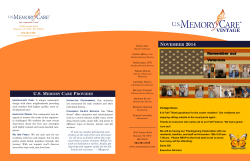
Legislation to Increase Graduate Medical Education Residency Limits
Healthcare Committee Legislation to Increase Graduate Medical Education Residency Limits On April 30, 2015 Senators Charles Schumer (D-NY), Bill Nelson (D-FL), and Harry Reid (D-NV) and Representatives Joe Crowley (D-Queens/Bronx) and Charles Boustany (R-LA) in the Senate and House, respectively, filed legislation to increase the numbers of resident positions currently used by Medicare to calculate hospital reimbursement for the expenses associated with providing graduate medical education to physicians in the United States. If enacted, the “Resident Physician Shortage Reduction Act of 2015” (S. 1148/H.R. 2124) would create 3,000 additional full time equivalent residency slots each year from 2017 through 2021, for a total of 15,000 new residency slots. At least half of the 3,000 slots must be used for a “shortage specialty residency program” as defined by the Health Resources and Services Administration. According to a statement by the American Association of Medical Colleges, the legislation would “provide a modest increase in Medicare support for graduate medical education by creating an additional 15,000 residency slots over five years.” Its supporters believe that the increase is necessary in order to meet the growing demand for doctors, especially in light of the changes brought about by the Affordable Care Act. I. Graduate Medical Education Graduate medical education is the second phase of the formal educational process that prepares doctors for medical practice. In general, physicians must complete a minimum of 11 years of higher education and training before beginning an independent medical practice. This typically consists of four years of undergraduate studies, four years of medical school and some three to seven years as a medical resident in a residency (graduate medical education) program. Medical residents work at teaching hospitals where they receive supervised, hands-on training in clinical specialties such as pediatrics or surgery. Residency programs can be followed by fellowships, during which time physicians receive additional subspecialty training. Since its inception in 1965, the Medicare program has provided funds to help teaching hospitals cover a portion of the higher costs associated with their unique patient care, education and research missions. The Centers for Medicare and Medicaid Services (“CMS”) reimburses teaching hospitals 98 North Washington Street ▪ Boston, MA 02114 (617) 723-4009 331 Constitution Avenue NE ▪ Washington DC 20002 (202) 547-9149 May 7, 2015 for some of the costs incurred in training residents through graduate medical education payments and indirect medical education adjustments. Each year the federal government contributes about $9.5 billion in Medicare funds, and approximately $2 billion in Medicaid dollars, to help pay for graduate medical education. CMS is the single largest funder of graduate medical education in the United States. As referenced, CMS generally makes two types of payments for graduate medical education: direct graduate medical education (“DGME”) payments and indirect medical education (“IME”) adjustments. DGME payments cover the identifiable costs of training residents, such as salaries, fringe benefits, and the cost of administering resident training programs. IME adjustments cover harderto-quantify costs associated with the teaching of residents and the education process, including: • • • Increased demands placed upon staff participating in the education process; Increased numbers of tests and procedures performed by residents as they learn their medical specialties; and The fact that teaching hospitals tend to attract sicker patients and provide more specialized services. A. Reimbursement Limits Both reimbursements are based, in part, on the number of full-time equivalent (“FTE”) residents a hospital trains and the number of Medicare patients it treats. Through the Balanced Budget Act of 1997, Congress limited the number of FTE residents that a hospital may count at the number that the hospital trained during its most recent cost reporting period that ended on or before December 31, 1996. This limit went into effect for the 1998 cost reporting year. Since then, many teaching hospitals have continued to expand their programs and to add additional programs. Now, some 16 years later, these hospitals may train dozens, or even hundreds, of residents above the level that they trained in 1996, while receiving no payment from the Medicare program for residents above the 1996 limit. II. The Resident Physician Shortage Reduction Act of 2015 Sponsors of the legislation state that medical school enrollment is growing, yet the number of residency positions remains subject to legislatively imposed limits, meaning that these medical school graduates will have no place to finish their required training. Additionally, last year, an investigation www.newenglandcouncil.com Page 2 May 7, 2015 by the Department of Veterans affairs concluded that many VA hospitals do not have enough primary care doctors, contributing to long wait times for care. A. Summary The legislation requires the Secretary of Health & Human Services (“Secretary”) to increase the number of residency “slots” by 3,000 each year from 2017 through 2021, with at least 1,500 each year to be used for a shortage specialty residency program. A shortage specialty residency program is defined as any approved residency training program in a specialty identified by the Health Resources and Services Administration until the National Health Care Workforce Commission (established by the Affordable Care Act) issues a report on specialty shortages in January of 2018. In determining whether a hospital should receive additional slots, the Secretary will consider the likelihood of the hospital filling the positions. Hospitals will be prioritized in the following order: 1. Hospitals in states with new medical schools or that have established additional branches or locations for existing medical schools; 2. Hospitals that have exceeded their resident limit at the time of enactment; 3. Hospitals that are affiliated with Veteran’s Health Administration medical centers; 4. Hospitals that emphasize training in community-based settings or in hospital outpatient departments; 5. Hospitals that are determined to be eligible for incentive payments as “meaningful users” of electronic health records; and 6. All other hospitals. A hospital that receives an increase in its residency slots must at all times ensure that (i) at least 50 percent of the slots are for a shortage specialty residency program, (ii) the total number of FTE residents (excluding additional positions attributable to the increase) is not less than the average number of FTE residents the hospital has trained during the three most recent cost reporting period, and (iii) the ratio of FTE residents in a shortage specialty residency program is not less than the average ratio of FTE residents in such program during the three most recent cost reporting periods. If a hospital fails to meet the foregoing criteria for maintaining its additional slots, the Secretary can reduce and redistribute the slots. A hospital may not receive more than 75 slots in the aggregate www.newenglandcouncil.com Page 3 May 7, 2015 from 2017 through 2021, unless the Secretary determines there are extra slots available for distribution. Finally, if the number of FTE slots distributed in a particular year is less than the aggregate number of positions available for that year, those slots will be available for distribution the following year. A copy of the Resident Physician Shortage Reduction Act of 2015 is available at http://www.hanys.org/news/docs/gme_slots.pdf. * * * This Committee Update provides general information and not legal advice or opinions on specific facts www.newenglandcouncil.com Page 4
© Copyright 2025









